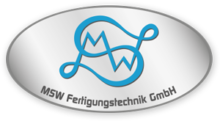Welding
Welding
During welding different workpieces are permanently joined by heat or pressure. In the process an additional welding material can be used, for example welding wire, which is placed and melted between the workpieces and hardening afterwards.
By applying different modern welding procedures such as MIG, MAG and WIG, as well as hard soldering, soft soldering and plastic welding, we are able to process almost all metal and different plastic materials.
Turning
Turning
Turning is one of the mostly applied cutting technology. In this process, a workpiece is clamped into a machine where it rotates about its own axis. Gradually the raw part is shaped with a so-called turning tool passing along the contour of the raw part.
On our advanced CNC turning machines we are able to process workpieces with a diameter of up to 700 mm x 2000 mm. Besides prototypes and individual items we also produce in low volume and large volume series.
Wire EDM
Wire EDM
During wire EDM or also wire cutting, electrically conductive materials are precisely cut with a thin running wire and put into shape. The method uses the so-called spark erosion, by which an electric voltage produces sparks, which precisely cut the workpiece.
With our advanced CNC wire EDM we are able to process workpieces of different quality and version on five axes, of a size of up to 600 mm x 400 mm x 210 mm.
Water jet cutting
Water jet cutting
During water jet cutting the workpieces are precisely cut by a hard, millimetre thin water jet. A difference is made between pure water cutting and abrasive water jet cutting where a hard, powder additive is added to the water.
On our professional CNC machines we can also accurately process large workpieces with dimensions of 4000 x 2000 x 200 mm – from individual piece up to medium volume series.
Surface grinding
Surface grinding
Surface grinding is the grinding of flat surfaces. In the process, the grinding tool is moved with pressure over the workpiece creating a perfectly smooth surface.
We are able to process workpieces of different materials with a dimension of 1000 x 1000 x 1000 mm – and of course absolutely accurate.
Circular grinding
Circular grinding
During circular grinding a rotating grinding tool is used for grinding cylindrical parts to the demanded diameter. A difference is made between internal grinding, for example for grinding bore holes, and the external grinding used for grinding cylindrical workpieces to measure.
On our advanced machines workpieces with a diameter of up to 500 mm and a length of up to 1600 mm can be processed reliably and accurately.
Vibratory grinding
Vibratory grinding
For vibratory grinding, workpieces mostly of metal are put with so-called abrasive bodies in an aqueous additive into the drums of a machine. Depending on the abrasive body, the workpiece is deoiled or degreased, deburred, ground, matted, smoothed or polished by rotation or oscillation.
We offer the rotating as well as the oscillating method, and have the ability to give the “finishing touch” to the most different workpieces.
CNC folding
CNC folding
For the so-called folding, flat workpieces of sheet metal are bent to shape. During the process the sheet metal is in a so-called press brake and is formed by pressure via a V-shape notch.
For folding, of course we also use a computer-controlled CNC method. On our advanced machines we can easily process sheet metal with a thickness of 6 mm, and a measure of 2500 mm x 500 mm.
Laser marking
Laser marking
Laser marking is a method, that applies with a strong laser beam lettering, patterns or markings permanently to a surface. This changes the material itself at the corresponding position.
We are working with fibre lasers as well as with CO2 laser procedures. The latter can be used for refining workpieces with a format of up to 2500 mm x 1250 x 200 mm. For fibre lasering we work with a mobile head, which can be variably applied and therefore does not know dimensional limits.
Engraving
Engraving
For engraving, lettering, patterns or markings are lasered or milled into metal workpieces, but also into other solid materials such as stone or glass. Different effects can be achieved depending on the shape of the applied tool.
We are able to carry out high-quality engravings in most different materials. In combination with our other processing methods we offer solutions from one single source – from shaping up to finishing. Depending on the method – for example during fibre lasering – we work without dimensional limits and are able to engrave workpieces of all sizes.
3D printing
3D printing
For 3D printing a special granulate material is applied layer by layer until a three-dimensional object is emerging.. This innovative processing technology most of all is appropriate for manufacturing workpieces and figures of synthetic resin and plastic materials as well as for Rapid Prototyping.
The most different workpieces of plastic can be manufactured on our 3D printers, quick and accurate in every detail by infeed of continuous carbon fibre filaments. Base are the according CAD/CAM files, which we will be happy to create for you.
UV printing
UV printing
UV printing works with a special UV reactive ink, which is directly applied to the respective workpiece. With UV light the colour hardens immediately and is perfectly joined with the printing medium. Almost every material and every surface can furnished with the most different colours and special effects, from 3D effect up to genuine white printing.
Another advantage: Because UV ink manages without thinner or solvent, this digital direct printing method is particularly environmentally friendly.
Our UV printers can process print media with a size of 900 mm x 600 mm (DIN A1) and a height of up to 150 mm. Moreover, cylindrical objects with a diameter of up to 150 mm can be processed.

